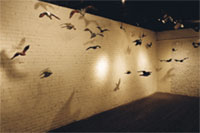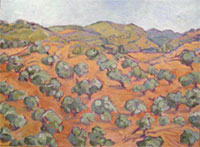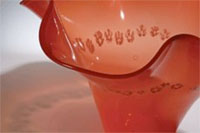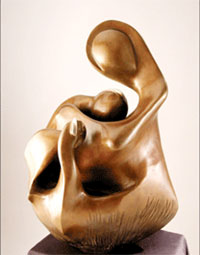- Art Tourists
- Colorado Art
- Interviews
- Archive
- Contact
- About Us
- Home
What is the purpose of art?
Answers by photographer Todd Powell, sculptor Maria Morley, painter Leona Sophecles Brownson, glass artist John Hudnut, and sculptor Chaz dellaPorta:
with Terry Talty
May, 2008
Talty: What is the purpose of art today, in the 21st Century?
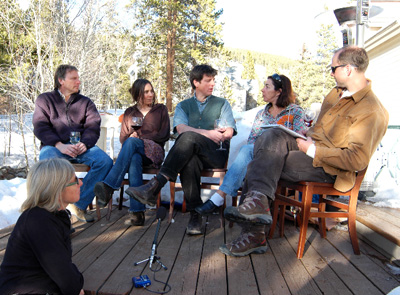
Todd: My art is successful when it makes a connection, when people say that the picture means something to them whether that’s what it meant to me or not. In this way, it has transcended me. What I like about having the gallery is that I actually get to talk to people, and hear the reason they like a picture.
Chaz: It stuns me the depth and intimacy of what complete strangers say to me from having touched or seen an inanimate object I have fashioned. And it gives me hope, to stay on my path. I’ve chosen the path to make sculpture in a very traditional, sculptural sense. I’ve had all this training and have lots of knowledge of past objects. So I can improve on that, and learn from what people have already achieved, but that’s a very external thing. So if I let go of my mind, my beliefs, my perceptions, then what do I have. I have my passion and the door to my subconscious; I’m walking blindly following my senses, but I’m choosing to do that. I might stumble across a shape that has meaning or emanates a quality that is beyond me. Just as, if you make a picture that 5,000 people have a connection to and uncannily it is a similar connection, you’re touching on humanity that links those 5,000 people - not a personal experience of one.
Leona: Mary (Maria) walked in with me and said, ‘Look out there,’ and what she was pointing at was a beautiful grove of aspen trees and she said, ‘I immediately thought of you, but I don’t need that big window because I have one of your paintings at home.’ That’s what I do. I’m not concerned with being a realist, but I’m providing windows for people’s homes.
Todd: I think I am too, but I always question whether it's art or it's decoration. Is it fine art or is it decorative art?
Maria: Van Gogh called all of his work decorations in all of his writing to his brother.
Leona: 'Decorative' is back in.
Maria: I believe that what I’m attempting to do, and sometimes I might hit the nail on the head, is to document the myth of my day. Joseph Campbell said the myth (of our day) is a public dream. It’s required that it comes from me to reach a broader audience. The myth of our day, I think I’m trying to document that, whether it’s a feeling or a thought. I also think of my self as a sculptor of ideas. For many years I made product (ceramics) to sell, but only to work up to this point in my life where I can express my self, which is what I think my duty has always been.
John: Art is when all of a sudden, something is making you happy; the lights get brighter.
Talty: You’ve spent a lot of time learning how to blow glass, and for what purpose?
John: I use the studio as a platform to, kind of, uplift the spirit and put it to work, so that all of a sudden you are inspired in unexpected ways. I feel like I put a machine in motion.
Leona: You sound like you are raising a child?
Talty: Do you think making art is like raising a child?
Leona: It's nurturing. I don’t feel much different when I’m painting than when I’m nurturing my plants. There’s a common thing going on there.
Chaz: More than the question of what it is to be an artist, I ask 'what’s the role of a human being?' To earn an income is not very close to being a human being. The task of a human being is to shine our brightest -- we’re all different so it’s going to be manifest differently -- but literally to be a star shining, emanating that essence and quality of energy by doing our chosen craft. It’s not a question of being artists but the question for every human being. Be your identify that you had when you birthed into the world.
Talty: If this is just about self-expression, as W.H. Auden said, shouldn’t you just keep it to yourself?
John: I think your mother said that, too.
Chaz: The water’s been muddied by this concept of self-expression over the past fifty years. It only works to conjure up our lower tendencies.
Mary: I’m saying it has to matter. It has to matter in order to put it out there in the world. It comes from me, so I have to believe in myself to think it’s mattering to the world, that it’s relevant in this time and space.
Chaz: It comes from yourself, but not your ego. Whatever you do, whether you’re an artist or a lawyer or a shopkeeper, that’s the task of being a human being.
Todd: Mary said, “I used to make things to sell, I’ve moved beyond making products.” I feel like all the commercial work I did for 20 years prepared me and gave me the tools and experience to do what I need to do next. And I have ideas about what I’m going to do next, but at the same time I need to pay the bills.
Talty: Is there something that matters, as Mary said, in how you use a camera?
Todd: Sure. Vision matters. I’m editing through stuff for Copper Mountain today, and all I want to show them is stuff nobody has ever seen before. I’m out there screwing with my brain trying to make this next image different from any ski picture that somebody else could take. It’s commercial; it’s a product. Or is it art? I don’t know.
Maria: About time making art -- being the maker -- my idea of total contentment is when the day flies by and it’s always morning. I’m more emotionless when I’m doing that work.
Chaz: As soon as I live outside myself, and the American Culture is very good at enabling that, then there’s no one at home. Then, I’m making ‘product’ that is soulless.
John: It’s about visual memory. We really do see it. People have to do a lot to make their livings, but we have taken the time to SEE. We are some kind of people, like the cave painters, who can do things and see. And what we make: it’s for joy, for communication.
Talty: Twenty years from now what do you hope will be the effect of the work you’ve making now, here in Summit County?
Leona: I hope somebody needed what I made in their own lives. We can talk about beauty because that’s what I like to paint, but it doesn’t mean that everyone else needs that.
John: Yes, they do.
Todd: Everyone needs beauty.
John: Hiking, mountain biking, skiing, the specter of death that brings you right there to the edge, brings an edge to my work. We are experiencing nature.
Leona: I need to be outside, communing with nature.
Chaz: I accept I’m affected by my environment, externally, but our internal (self) may not necessarily be affected.
Talty: From an art historical perspective, is there any point of being an artist if you’re not in New York City?
Todd: I wouldn’t be making art if I lived in New York; I’d be making commerce. My art all comes from this experience of living here, being here, and living outside. All I want to do is be outside, and all I did today was sit inside with the blinds down looking at pictures on the computer. I wanted to be outside on this beautiful day, even if it was just walking down Main Street looking at light. I’m inspired by the natural world. I was thrilled to push my limits to create ski photography; all I wanted to show them was stuff they’d never seen before.
Talty: When are you pushing yourself?
Leona: When I’m trying to get it right.
Maria: If I was in NYC, I’d be in urban survival mode, and I’d much rather survive in the mountains. I’m not so into the death-defying skiing as I used to be, but I find a history that is mine, here. Maybe I think art in New York City is commodity, about having a name or money. I’m thinking I have a responsibility, something to say that is mine, and because I can get out in the woods and find some peace of mind, I can go back to work. I lived in a big city in Mexico. In this shrinking world maybe a place to call home is really important.
Talty: Your work called Migration was installed in San Miguel Allende and also this winter in Denver. How was it different in Colorado?
Maria: I brought in the birds; they were new. I always thought of birds as an important part of migration because that’s where the beauty is. Aren’t we all trying to fly? Whether it’s with our art, music, or skiing? It’s something about transcending this physical reality.

